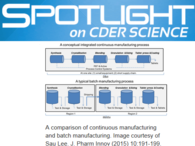


FDA warns Americans about risk of inaccurate results from certain lead tests
On May 17, 2017, the FDA and Centers for Disease Control and Prevention are warning Americans that certain lead tests manufactured by Magellan Diagnostics may provide inaccurate results for some children and adults in the United States. The CDC recommends that parents of children younger than six years (72 months) of age, and currently pregnant women and nursing mothers who have been tested for lead exposure consult a health care professional about whether they should be retested.
“The FDA is deeply concerned by this situation and is warning laboratories and health care professionals that they should not use any Magellan Diagnostics’ lead tests with blood drawn from a vein,” said Jeffrey Shuren, M.D., director of the FDA’s Center for Devices and Radiological Health. “The agency is aggressively investigating this complicated issue to determine the cause of the inaccurate results and working with the CDC and other public health partners to address the problem as quickly as possible.” FDA Press Announcement and More information
|

FDA Drug Safety Communication: FDA confirms increased risk of leg and foot amputations with the diabetes medicine canagliflozin (Invokana, Invokamet, Invokamet XR)
Based on new data from two large clinical trials, FDA has concluded that the type 2 diabetes medicine canagliflozin (Invokana, Invokamet, Invokamet XR) causes an increased risk of leg and foot amputations. We are requiring new warnings, including our most prominent Boxed Warning, to be added to the canagliflozin drug labels to describe this risk.
Patients taking canagliflozin should notify your health care professionals right away if you develop new pain or tenderness, sores or ulcers, or infections in your legs or feet. Talk to your health care professional if you have questions or concerns. Do not stop taking your diabetes medicine without first talking to your health care professional.
Untreated, type 2 diabetes can lead to serious problems, including blindness, nerve and kidney damage, and heart disease. Canagliflozin is a prescription medicine used with diet and exercise to lower blood sugar in adults with type 2 diabetes. It belongs to a class of drugs called sodium-glucose cotransporter-2 (SGLT2) inhibitors. Canagliflozin lowers blood sugar by causing the kidneys to remove sugar from the body through the urine. More information
|
Comunicaciones de la FDA sobre la seguridad de los medicamentos en español
Descargo de responsabilidad: La FDA reconoce la necesidad de proporcionar información importante sobre seguridad de los medicamentos en idiomas distintos al inglés. Hacemos lo mejor posible para proporcionar versiones en español precisas y oportunas de nuestras Comunicaciones de Seguridad de Medicamentos. Sin embargo, en caso que existiera discrepancias entre las versiones en inglés y la de español, la información contenida en la versión en inglés es la que se considera como versión oficial. Si tiene alguna pregunta, por favor contáctese con Division of Drug Information en druginfo@fda.hhs.gov. Comunicaciones de la FDA |


FDA knows the major public health consequences that can result from drug shortages. These shortages occur for many reasons including manufacturing and quality problems, delays and discontinuations. When issues are discovered, FDA works closely with the company to address risks involved to prevent harm to patients. FDA also considers the impact a shortage would have on patient care and access and works with the company to restore supplies while also ensuring safety for patients. More information
|
Drug Shortages Voluntarily Reported by Manufacturers During the Past 2 Weeks:
Drug Shortages Reported to be Resolved by Manufacturers During the Past 2 Weeks:
Drug Discontinuation Voluntarily Reported by Manufacturers During the Past 2 Weeks:
- Delavirdine Mesylate (RESCRIPTOR) Tablets
- Galantamine Tablets
- Glyburide Metformin Tablets
- Glyburide Tablets
- Indomethacin Capsules
- Methylphenidate Hydrochloride Tablets, USP
Information about blood and biologic shortages, resolved shortages, and discontinuations
La FDA reconoce las consecuencias significativas para la salud pública que pueden resultar de la escasez de medicamentos y hace un gran esfuerzo dentro de sus facultades legales para abordar yprevenir la escasez de medicamentos. La escasez se produce por muchas razones, incluyendo problemas de fabricación y calidad, retrasos y discontinuación del producto. Cuando los problemas son descubiertos por la empresa o el público y reportados a la FDA o se descubren por inspecciones de la FDA, la FDA trabaja en estrecha colaboración con la empresa para hacer frente a los riesgosinvolucrados y evitar daños a los pacientes. La FDA también considera el impacto que una escaseztendría en la atención médica del paciente y al acceso del producto y trabaja con la empresa pararestablecer el suministro al tiempo que garantiza la seguridad de los pacientes. Más información
|

FDA approves first cancer treatment for any solid tumor with a specific genetic feature
On May 23, 2017, FDA granted accelerated approval to a treatment for patients whose cancers have a specific genetic feature (biomarker). This is the first time the agency has approved a cancer treatment based on a common biomarker rather than the location in the body where the tumor originated.
Keytruda (pembrolizumab) is indicated for the treatment of adult and pediatric patients with unresectable or metastatic solid tumors that have been identified as having a biomarker referred to as microsatellite instability-high (MSI-H) or mismatch repair deficient (dMMR). This indication covers patients with solid tumors that have progressed following prior treatment and who have no satisfactory alternative treatment options and patients with colorectal cancer that has progressed following treatment with certain chemotherapy drugs. More information
|

First drug to specifically treat giant cell arteritis aproved
On May 22, 2017, FDA expanded the approved use of subcutaneous Actemra (tocilizumab) to treat adults with giant cell arteritis. This new indication provides the first FDA-approved therapy, specific to this type of vasculitis.
“We expedited the development and review of this application because this drug fulfills a critical need for patients with this serious disease who had limited treatment options,” said Badrul Chowdhury, M.D., Ph.D., director of the Division of Pulmonary, Allergy, and Rheumatology Products in the FDA’s Center for Drug Evaluation and Research. More information
FDA authorizes use of new device to treat esophageal birth defect in babies
On May 12, 2017, FDA authorized use of the Flourish Pediatric Esophageal Atresia Anastomosis, a first-of-its-kind medical device to treat infants up to one year old for a birth defect that causes a gap in their esophagus, called esophageal atresia.
An estimated 1 in every 2,500 babies in the U.S. is born with esophageal atresia. Babies with this condition cannot feed normally, and they require a feeding tube until surgery can be performed to attach the esophagus to the stomach. Most babies born with esophageal atresia also have a tracheoesophageal fistula, which also needs to be repaired surgically, since fluids from the esophagus can get into the airways and interfere with breathing. More information
|

FDA expands approved use of Kalydeco to treat additional mutations of cystic fibrosisOn May 17, 2017, FDA expanded the approved use of Kalydeco (ivacaftor) for treating cystic fibrosis. The approval triples the number of rare gene mutations that the drug can now treat, expanding the indication from the treatment of 10 mutations, to 33. The agency based its decision, in part, on the results of laboratory testing, which it used in conjunction with evidence from earlier human clinical trials. The approach provides a pathway for adding additional, rare mutations of the disease, based on laboratory data. More information
|
For information on drug approvals or to view prescribing information and patient information, please visit Drugs@FDA or DailyMed.

View FDA's Comments on Current Draft Guidance page, for a list of current draft guidances and other topics of interest for patients and caregivers.
|

Request for Public Comment: Enhancing Patient Engagement Efforts Across the FDA
On March 13, 2017, the FDA released a notice in the Federal Register establishing a public docket to solicit input on ongoing efforts to enhance mechanisms for patient engagement at the Agency. Engaging with patients, their caregivers, and advocates has long been a priority of the Agency. In this tradition, FDA intends to enhance future patient engagement by providing a more transparent, accessible, and robust experience for patient communities. To achieve these goals, FDA is considering establishing a new Office of Patient Affairs. This concept was directly informed by the public feedback solicited through the prior public docket regarding FDA's stakeholder engagement responsibilities outlined by the Food and Drug Administration Safety and Innovation Act (FDASIA). The purpose of this notice is to outline FDA's proposal for the future of patient engagement at the Agency so that the perspectives of patient communities can be better captured. To learn more about the ways the FDA is currently working with patients visit the FDA Patient Network and we encourage you to submit your comments to the Federal Register before the comment period closes on June 12, 2017. |

FDA Commissioner Asks Staff for ‘More Forceful Steps’ to Stem the Opioid Crisis, by Scott Gottlieb, M.D., Commissioner of FDA
As Commissioner, my highest initial priority is to take immediate steps to reduce the scope of the epidemic of opioid addiction. I believe the Food and Drug Administration continues to have an important role to play in addressing this crisis, particularly when it comes to reducing the number of new cases of addiction.
Today, I sent an email to all of my colleagues at FDA, sharing with them the first steps I plan to take to better achieve this public health goal. With this, my first post to the FDA Voice blog, I also wanted to share my plans with you.
I believe it is within the scope of FDA’s regulatory tools – and our societal obligations – to take whatever steps we can, under our existing legal authorities, to ensure that exposure to opioids is occurring under only appropriate clinical circumstances, and for appropriate patients.
To read the rest of this post, see FDA Voice Blog on May 23, 2017.
|

Modernizing the Way Drugs Are Made: A Transition to Continuous Manufacturing by: Sau (Larry) Lee, Ph.D., Deputy Director of the Office of Testing and Research, and Chair of the Emerging Technology Team, Office of Pharmaceutical Quality, CDER
For more than 50 years, pharmaceuticals have been produced using a method known as “batch manufacturing,” a multi-step, lengthy process that involves the use of ungainly, large-scale equipment. However, recent advances in manufacturing technology have prompted the pharmaceutical industry to consider moving away from batch manufacturing to a faster, more efficient process known as continuous manufacturing. The FDA is taking proactive steps to facilitate the drug industry’s implementation of emerging technologies, including continuous manufacturing, to improve product quality and address many of the underlying causes of drug shortages and recalls. More information |

Reducing Preventable Harm from Medications: Too Big for FDA to Do Alone by: John J. Whyte, M.D., M.P.H., Director of Professional Affairs and Stakeholder Engagement at FDA’s Center for Drug Evaluation and Research
Sometimes a drug can be used exactly as FDA approved it, taken just the way a doctor prescribed it, and a patient can still experience adverse events. When it comes to drugs, not all risks are known – even after approval.
Sadly, however, harm from medications also may come from known risks that could have been prevented. The Institute of Medicine (now called the National Academy of Medicine) estimated that at least 1.5 million preventable adverse drug events occur within our health care system each year. It’s a complex system where safety issues can arise at any turn.
Among the many challenges, prescribers and other providers often struggle with the intricacies of today’s health care system, patients can have difficulty following detailed directions, and manufacturers must carefully package and label their products to avoid confusion and misunderstanding for how they are used.
To read the rest of this post, see FDA Voice Blog on May 16, 2017
|

Radiating Shoe Sales, by: Vanessa Burrows, an FDA Historian
Since the discovery of X-rays in the late 19th century, the technology has enhanced health care in a variety of ways. Like many cutting-edge scientific developments, however, it also has inspired uses of uncertain therapeutic value. That was the case with the shoe-fitting fluoroscope, the subject of the latest episode of FDA’s history video series.
Marketed as a scientific method for optimizing shoe fit, the fluoroscope appeared in shoe stores nationwide from the 1920s to the 1960s. But the machines not only didn’t do what they promised, they also exposed children, their parents, and store clerks to unhealthy doses of radiation.
In the late 1940s, scientists and regulators began to raise serious concerns about the dangerous levels of radiation. Over the next two decades, individual states gradually took action to either ban or restrict the use of the device.
To read the rest of this post, see FDA Voice Blog on May 18, 2017
|

In this section you will find a comprehensive list of all the meetings that the FDA is involved with. The meetings may include advisory committee meetings, public workshops and public conferences that are seeking to hear from patients and caregivers.
Most FDA meetings are free to the public and do not require the public to register. Interested persons may present data, information, or views, orally at the meeting, or in writing, on issues pending before the committee. Other types of meetings listed may require prior registration and fees.
|
View FDA's Patient Network Calendar of Public Meetings page for a complete list of meetings and workshops.
For additional information on other agency meetings please visit Meetings, Conferences, & Workshops.
|

How to Safely Use Glucose Meters and Test Strips for Diabetes
The FDA is aware that some sellers are marketing pre-owned or secondhand test strips to consumers. These are unused test strips previously owned by someone else.
These pre-owned strips may be sold at lower prices when compared to new strips. For instance, you may see flyers advertising cheap test strips in your neighborhood, or you may see sellers marketing cheap test strips online. More information
|

What to Know When Buying or Using a Breast Pump
If you’re giving your baby breast milk, you probably know there can be times when a breast pump can come in handy.
Breast pumps are medical devices regulated by the U.S. Food and Drug Administration. They can be used to maintain or increase a woman’s milk supply, relieve engorged breasts and plugged milk ducts, or pull out flat or inverted nipples so a nursing baby can latch on more easily.
And there are important safety considerations if you use one.
|
More Consumer Updates
For previously published Consumer Update articles that are timely and easy-to-read and cover all FDA activities and regulated products. More information
For previously published Consumer Update articles that are timely and easy-to-read and cover all FDA activities and regulated products. More information
En Español
La información en esta página es para el público en general, y para profesionales y educadores de salud. Esta información puede ser distribuida y publicada sin previa autorización. En Español
La información en esta página es para el público en general, y para profesionales y educadores de salud. Esta información puede ser distribuida y publicada sin previa autorización. En Español

Frequently Asked Questions about Food Allergies
Symptoms of food allergies typically appear from within a few minutes to two hours after a person has eaten the food to which he or she is allergic.
Allergic reactions can include:
People with food allergies can also experience a severe, life-threatening allergic reaction called anaphylaxis after eating a food allergen(s). More information
|

The Safety Reporting Portal
The Safety Reporting Portal (SRP) streamlines the process of reporting product issues to the Food and Drug Administration and the National Institutes of Health. Whatever your role, (manufacturer, health care professional, researcher, public health official, or concerned citizen), when you submit a safety report through this Portal, you make a vital contribution to the safety of America's food supply, medicines, and other products that touch us all. More information
Center for Food Safety and Applied Nutrition
The Center for Food Safety and Applied Nutrition, known as CFSAN, carries out the mission of FDA. The Center provides services to consumers, domestic and foreign industry and other outside groups regarding field programs; agency administrative tasks; scientific analysis and support; and policy, planning and handling of critical issues related to food and cosmetics. More information
Food Facts for You
The Center for Food Safety and Applied Nutrition, known as CFSAN, issues food facts for consumers to keep you and your family safe. More information |

Animal Health LiteracyAnimal Health Literacy means timely information for the benefit of all animals and their humans. With continuous communication and outreach, the Center for Veterinary Medicine (CVM) strives to enhance the public trust, promote safe and effective use of the animal health products we regulate, and share our scientific endeavors. CVM provides reliable, science-based information to promote animal and human health. More information and Publicaciones en Español del FDA
Animal and Veterinary UpdatesAnimal and veterinary updates provide information to keep your pets healthy and safe. More information
|

How to Report a Pet Food Complaint
You can report complaints about a pet food product electronically through the Safety Reporting Portal or you can call your state’s FDA Consumer Complaint Coordinators. Please provide as much information as possible in your complaint, such as exact name of product, type of container, lot number, UPC codes, how the food was stored, and purchase date and exact location where purchased. If possible, please save the original packaging until the pet food has been consumed. The packaging contains IMPORTANT information often needed to identify the variety of pet food, the manufacturing plant, and the production date. More information |

Missed the last issue of CTPConnect?
The Center also publishes a regular periodical known as CTPConnect, a plainspoken digest with the latest stories from the Center. Sign up today to receive the next issue of CTPConnect and other important updates from CTP directly to your inbox. |

Tips to help avoid "vape" battery explosionsYou may have heard that e-cigarettes, or "vapes," can explode and seriously injure people. To help reduce the risk of vape battery overheating, fires, and explosions, the FDA has developed an infographic with five key tips, a video on how to report adverse events to the FDA’s Safety Reporting Portal, and shareable and downloadable content to help spread the word about vape battery safety.
How cigarettes are made and how you can make a plan to quit
Ever wonder why it’s so hard to kick smoking to the curb? Well, we’ve got an answer! CTP created an infographic that explores how cigarettes are made, highlighting how their very design may be an obstacle to quitting. As people across the country pledge to quit smoking, consider sharing this infographic with someone who could benefit.
From plant to product to puff—where do toxic chemicals in cigarettes come from?
With more than 7,000 chemicals in cigarette smoke—over 70 of which are linked to cancer—it comes as no surprise that cigarettes contain harmful chemicals that cause death and disease. But where do these toxic chemicals come from? And why are there so many? Watch the FDA’s video series about chemicals in cigarettes to find out, and test your knowledge with our short quiz online. |

Bad reaction to a cosmetic? FDA needs to know
What do you do if you have a reaction after using a cosmetic product? First, stop using the product and contact your healthcare provider. Next, please report it to FDA.
Here’s why that next step is so important: Cosmetic products aren’t required by law to have FDA approval before they go on the market. Companies that market cosmetics have a legal responsibility to ensure product safety, but FDA can only take action if the product is shown to be unsafe after the product is on the market.
And, because the law doesn’t require cosmetic companies to share customer complaints or other safety information with FDA, voluntary reports from consumers and healthcare providers are one of the best ways for FDA to learn about any problems.
Cosmetics include a range of products people use every day, such as moisturizers, makeup, shampoos and conditioners, face and body washes, deodorants, nail care products, hair dyes and relaxers, and tattoos. More information
|
Recalls and Alerts
To see safety alerts and recent recalls related to cosmetics and other products regulated by FDA. More information
To see safety alerts and recent recalls related to cosmetics and other products regulated by FDA. More information
What to watch for, how to report
You can report an allergic reaction, a rash, redness, burn, hair loss, headache, infection, illness, or any other unexpected reaction, whether or not it required medical treatment. You can also report a bad smell, color change, or other sign of contamination. You can choose the way you’d prefer to report:
You can report an allergic reaction, a rash, redness, burn, hair loss, headache, infection, illness, or any other unexpected reaction, whether or not it required medical treatment. You can also report a bad smell, color change, or other sign of contamination. You can choose the way you’d prefer to report:
- Call an FDA Consumer Complaint Coordinator if you want to speak directly to a person about your problem.
- Complete an electronic Voluntary MedWatch form online.
- Complete a paper Voluntary MedWatch form that you can mail to FDA.

Information about Expanded Access
Expanded access, sometimes called "compassionate use," is the use outside of a clinical trial of an investigational medical product (i.e., one that has not been approved by FDA). FDA is committed to increasing awareness of and knowledge about its expanded access programs and the procedures for obtaining access to human investigational drugs (including biologics) and medical devices. More information |
Learn about what your physician should do before submitting a request for individual patient expanded access use of an investigational medical product, who may be eligible for expanded access, associated costs, FDA contacts and more. Information for Patients
|
Learn about your responsibilities under the expanded access pathway, how to submit a request for expanded access for an individual patient (including for emergency use), which forms to use, FDA contacts and more. Information for Physicians
|

FDA Patient Network
The FDA Patient Network contains a series of webpages, webinars and presentations on topics related to patient engagement, FDA regulations, understanding medical product (Drugs, Biologics, and Devices) approval and medical product safety updates, Take me to the FDA Patient Network , Follow us on twitter or take me to FDA Webinars.
FDA Webinars
FDA Basics
Each month, different centers and offices at FDA will host an online session where the public can ask questions to senior FDA officials about a specific topic or just listen in to learn more about FDA. More information
FDA Email Updates
Sign up for one of the FDA disease specific e-mail list that delivers updates, including product approvals, safety warnings, notices of upcoming meetings, and notices on proposed regulatory guidances. |





















.png)












No hay comentarios:
Publicar un comentario